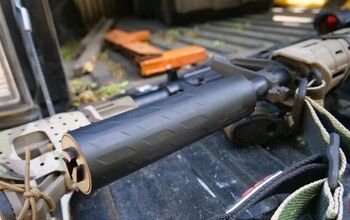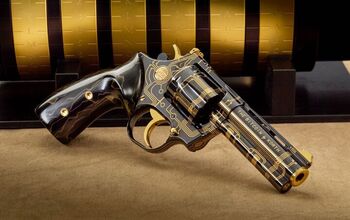Silencer Saturday #382: Noveske's New Amigo

Good afternoon everyone and welcome back to TFB’s Silencer Saturday, brought to you by Yankee Hill Machine, manufacturers of the new Victra-12 shotgun suppressor. This week we're looking at an interesting new suppressor from Noveske. The Amigo is a compact rifle silencer made to work on Flaming Pig muzzle devices.
Silencer Saturday @ TFB:
- Silencer Saturday #381: Engaged Industries Operator 5.56 Suppressor
- Silencer Saturday #380: Suppressors V. Brakes On Competition Guns
- Silencer Saturday #379: The Ultra Lightweight TiOn Dragoon 7.62 QD
- Silencer Saturday #378: IWI Get Into The Silencer Game
- Silencer Saturday #377: BOE Suppression Mod 1S
Background
Noveske's KX-3 flaming pig muzzle device should be familiar to most of this readership. It may be one of the most recognizable firearm parts from the 2000s and 2010s. This little cylindrical muzzle device takes the large blast and concussion signature inherent in rifles with shorter barrels.
The Flaming Pig came about at a time when ARs were growing in popularity while also shrinking in size. Short barrels were all the rage, spurred at least in part by Coalition military operations in Iraq and Afghanistan being heavily mechanized. Full-size rifles offer great muzzle velocity, but they are very difficult to handle when crammed into a vehicle with several other guys, all heavily armed and heavily armored.
But those short little guns are horribly uncomfortable to be around during firing. Short barrels burn a lot of propellant outside the barrel, resulting in large fireballs and the noise that comes along with them. The Flaming Pig has an outer cylindrical body with a cone inside it. The large end of the cone faces forward, and that leaves a gap behind it in the space between the outer body and the barrel.
Noveske has two patents for the KX-3. The patents explain what the Flaming Pig does in a very thorough way, so here are some quotes that outline it better than I can:
“The forcing cone traps the expanding gases from the discharged firearm and delays their exit to the atmosphere thereby generating more back pressure. This increased back pressure aids in the reliable operation of short barreled autoloading firearms...
The gas expansion gap allows the high pressure gases behind the bullet to expand into the flash suppression chamber. This results in temporary containment of the initial concussion with a gradual release of pressure and concussion in a forward direction. This action reduces the concussion felt by the shooter. The impact of the gases on the forward section of the cone and inside of the body also helps counter the recoil felt by the shooter, thereby making the weapon more controllable while being fired.”
So, rather than changing some flow characteristics or using harmonics to break up gas like many flash hiders, the KX-3 is doing a few things at once. Trapping the gases to delay their expansion out of the gun barrel is very similar to what most silencers do, but the ATF has ruled it is not a silencer. And front firsthand experience, it does help mitigate the concussion and muzzle flash, but it is still quite loud.
The Amigo
The greatest downside of the Flaming Pig was always that it was mutually exclusive with silencers. By choosing a KX-3 you were choosing to run unsuppressed at all times. This was even more true where the KX-3 was permanently installed on a barrel. On a gun with a 16-inch barrel where the Pig would not be pinned to the barrel it would be possible to remove it and swap to a different muzzle device and/or a silencer, but that is usually a task performed at a workbench instead of out in the field. But if the Pig is welded onto a sub-16-inch barrel to get it up to 16 inches, it is basically stuck. Removing it becomes a matter for a gunsmith (or, maybe, a Dremel-wielding “gunsmif” who would probably destroy it in the process of removing it).
But the Amigo flips that on its head. It is designed around the KX-3 and screws into the threads used to hold the forcing cone in place. As you can see from this image, the back end of the Amigo slips down into the space that would be the expansion chamber of the Pig and uses a sort of helical baffle system. The front of the silencer has a more traditional cylindrical appearance.
The front end has the Noveske logo, but look closely around the edges. That looks an awful lot like the Purposely Induced Porosity pioneered by PTR and used in other silencers like the Dillon Rifle Company offerings. PTR is clearly willing to license that tech for use by other companies, and that sure looks like what we are seeing here. Note also there are small holes around the outer front radius that vent more gas forward.
Looking more closely at the design and features of the Amigo, we see several new trends across the industry at play here. This can is made from Haynes 282, which we profiled in an earlier Silencer Saturday. Haynes 282 is an incredibly strong material that can hold up to the harshest of firing schedules with minimal wear. The Amigo is also made using additive manufacturing, allowing for more complex internal designs like the helical chambers on the rear portion and forward venting elements. These new technologies are fast becoming the industry standard.
All of the Amigo pictures are courtesy of my friends at Gallenson’s Guns, the oldest gun store in America. They have the Noveske Amigo in stock on their website as of writing for $799. If you have a KX3 on a gun already, or if you always wanted one but the lack of suppressor compatibility kept you from buying one, you now have no excuse!
SILENCER SHOP – HANSOHN BROTHERS – DEADEYE GUNS
MAC TACTICAL
ALL YHM PRODUCTS AT BROWNELLS
DEALERS: If you want your link to buy YHM suppressors included in future Silencer Saturday posts, email: silencers@thefirearmblog.com

AKA @fromtheguncounter on Instagram. Gun nerd, reloader, attorney, and mediocre hunter.
More by Daniel Y














![[SHOT 2025] Jacob Grey TWC Hex](https://cdn-fastly.thefirearmblog.com/media/2025/01/26/00051/shot-2025-jacob-grey-twc-hex.jpg?size=350x220)









![[SHOT 2025] Steyr Monobloc: The Barrel And Receiver Are One Piece!](https://cdn-fastly.thefirearmblog.com/media/2025/01/24/14161/post.jpg?size=350x220)


Comments
Join the conversation
It doesn’t use PIP. It’s a license suppressor from Radical defense. They also manufacture Dead airs new 3d Haynes 282 cans.
Hey everyone,
I've recently been delving into the mechanics and performance of Rare Breed Triggers, particularly the FRT-15 series. Their design and functionality offer a unique shooting experience, and I'm keen to gather insights from fellow enthusiasts.
I've compiled some information and personal observations on this topic. If you're interested in a deeper dive or wish to share your experiences, feel free to connect. Rear breed trigger evolution discussion panel
Looking forward to a constructive discussion!